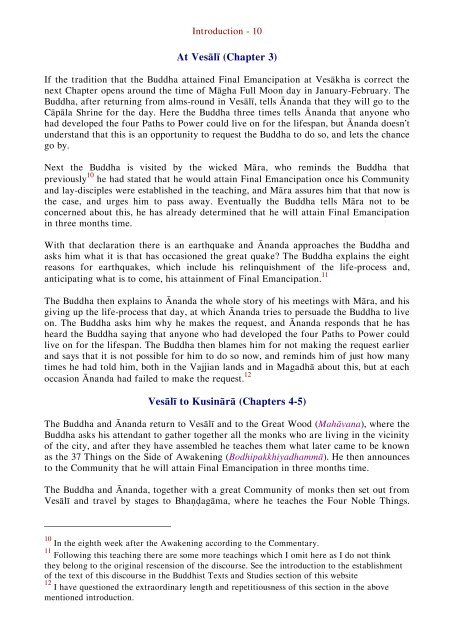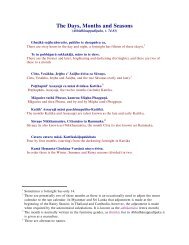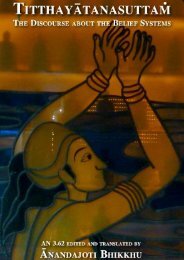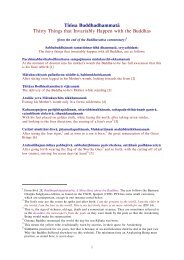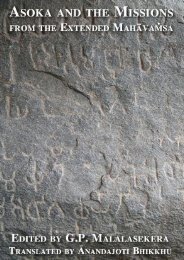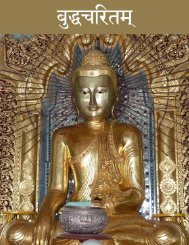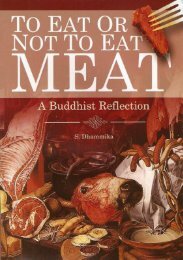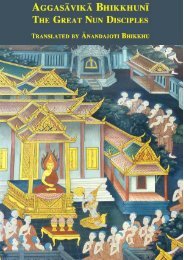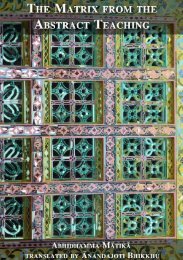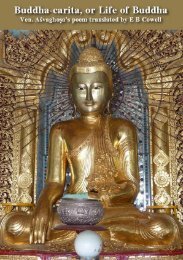Mahaparinibbanasuttam (DN 16) - Ancient Buddhist Texts
Mahaparinibbanasuttam (DN 16) - Ancient Buddhist Texts
Mahaparinibbanasuttam (DN 16) - Ancient Buddhist Texts
Create successful ePaper yourself
Turn your PDF publications into a flip-book with our unique Google optimized e-Paper software.
Introduction - 10<br />
At Vesālī (Chapter 3)<br />
If the tradition that the Buddha attained Final Emancipation at Vesākha is correct the<br />
next Chapter opens around the time of Māgha Full Moon day in January-February. The<br />
Buddha, after returning from alms-round in Vesālī, tells Ānanda that they will go to the<br />
Cāpāla Shrine for the day. Here the Buddha three times tells Ānanda that anyone who<br />
had developed the four Paths to Power could live on for the lifespan, but Ānanda doesn’t<br />
understand that this is an opportunity to request the Buddha to do so, and lets the chance<br />
go by.<br />
Next the Buddha is visited by the wicked Māra, who reminds the Buddha that<br />
previously 10 he had stated that he would attain Final Emancipation once his Community<br />
and lay-disciples were established in the teaching, and Māra assures him that that now is<br />
the case, and urges him to pass away. Eventually the Buddha tells Māra not to be<br />
concerned about this, he has already determined that he will attain Final Emancipation<br />
in three months time.<br />
With that declaration there is an earthquake and Ānanda approaches the Buddha and<br />
asks him what it is that has occasioned the great quake? The Buddha explains the eight<br />
reasons for earthquakes, which include his relinquishment of the life-process and,<br />
anticipating what is to come, his attainment of Final Emancipation. 11<br />
The Buddha then explains to Ānanda the whole story of his meetings with Māra, and his<br />
giving up the life-process that day, at which Ānanda tries to persuade the Buddha to live<br />
on. The Buddha asks him why he makes the request, and Ānanda responds that he has<br />
heard the Buddha saying that anyone who had developed the four Paths to Power could<br />
live on for the lifespan. The Buddha then blames him for not making the request earlier<br />
and says that it is not possible for him to do so now, and reminds him of just how many<br />
times he had told him, both in the Vajjian lands and in Magadhā about this, but at each<br />
occasion Ānanda had failed to make the request. 12<br />
Vesālī to Kusinārā (Chapters 4-5)<br />
The Buddha and Ānanda return to Vesālī and to the Great Wood (Mahāvana), where the<br />
Buddha asks his attendant to gather together all the monks who are living in the vicinity<br />
of the city, and after they have assembled he teaches them what later came to be known<br />
as the 37 Things on the Side of Awakening (Bodhipakkhiyadhammā). He then announces<br />
to the Community that he will attain Final Emancipation in three months time.<br />
The Buddha and Ānanda, together with a great Community of monks then set out from<br />
Vesālī and travel by stages to Bhaṇḍagāma, where he teaches the Four Noble Things.<br />
10 In the eighth week after the Awakening according to the Commentary.<br />
11 Following this teaching there are some more teachings which I omit here as I do not think<br />
they belong to the original rescension of the discourse. See the introduction to the establishment<br />
of the text of this discourse in the <strong>Buddhist</strong> <strong>Texts</strong> and Studies section of this website<br />
12 I have questioned the extraordinary length and repetitiousness of this section in the above<br />
mentioned introduction.


